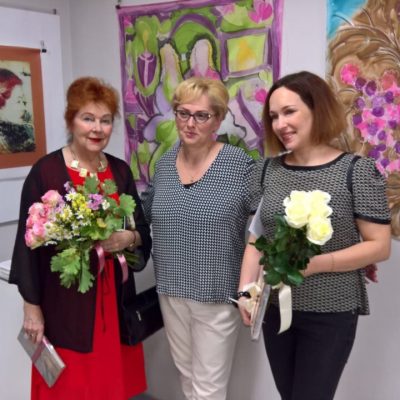VRBOVEC, Frankness of Beauty, Mala Gallery
October 13. 2017.
The opus of ceramicist and painter Ljerka Njerš holds a special place in contemporary Croatian art, and speaks of the significance of diversity, synthesis and symbiosis of different art techniques, mediums and materials in today’s ungrateful time of narrow specialization. The artist’s opus should therefore not be viewed only through the prism of unifying different kinds of applied art, but through a lasting desire to experiment and an openness to new possibilities in materials, genres and formatting techniques. The almost renaissance aspect of her artistic work is never lost in the quantity of artifacts, but is entirely subordinate to the idea of artistic perfection and the abstracting of motives into stylized and uniform sights – regardless of whether she creates in faience, maiolica, raku ceramics, glass, monotypes, silk painting, or in her latest work, a blend of photography and modern technology. Thus, when the art historian Ivanka Reberski asserted that such a sublimated purity of lines and shapes, whether they are floral motifs, the female figure or landscape, „has not been seen in our art practice since the times of secession and art déco, and even out of the artists of that era very few can match her“, such a laud had its concrete and easily confirmable ground in the artist’s opus. I have once already noticed that the specificity of Ljerka Njerš’s work is the overcoming of all possible limitations of a chosen medium and material, so it is sometimes hard to see at first glance whether we are looking at a painting, watercolour, or painted silk; a drawing, watercolour or monotype; clay or porcelain. In this fascinating and easy playing with the possibilities of a given material, Ljerka Njerš almost regularly paints on ceramics and raku, draws on glass, while she seeks to realize a sense of volume and space through a complex stringing of plans in the frames of landscape paintings on silk or nudes on small porcelain tablets and reliefs, in the clash of smooth and coarse glass glazes. For her, the two-dimensional aspect of a piece doesn’t seem to exist, and she pursues working around it as much as possible, to introduce the viewer into a world resting on the ancient models of ideal beauty, where beauty is one of the necessary virtues. The concept of reduced and stylized landscape without concrete geographical or architectural topos, filled with flowers, diverse trees, white doves, angels and semi-sitting or reclining female nudes symbolically signify the idea of a synthesis of nature and an evocation of permanent sources of beauty. The critic Vladimir Crnković stresses that „all of the artist’s nudes are always specifically unreal and abstract, transformed into ideal visions“, open to the renaissance metaphor of the so-called Garden of Eden, but also nearing the stylization of drawing and colouring chosen in the tradition of fauvism and Matisse. Regardless of the material and medium she chooses, the basic features of this artist’s handwriting are tied to the classical ideas of proportion, harmony and balance in the composition of works of art. In the newest cycle of painted silk, Ljerka Njerš surrenders to freely connecting fragments of landscape, water, vegetation and skies, and through the concept of colouristic pervasion and complementarity of colour she creates works of an exceptionally sensual, lyrical and at the same time expressive level of experience. In the entire opus the structural form of landscape has been brought to perfection, ofen employing the golden section, while a play with vertical, linear, aerial and colouristic perspective can be readily observed in the painted silk cycle. What sets apart the art and great skill of Ljerka Njerš in contemporary Croatian art is not only her remarkable ability in synthesis and invention, but also her freedom from trends and styles. She has always been intensely interested in matter and an exhaustive span of the possibilities of expression in one material, where the author’s subtle iconography (I. Reberski) occurred as a natural and simple part of creation. With no pathetic narrative or the use of overly decorative shapes and colours, Ljerka Njerš has managed to create an opus which in each of its fragments speaks of the beauty of the whole, the idea of nature as a metaphor for continued creation and the regeneration of life, and where sensualism and vitalism are positively balanced principles of creating.
Iva Körbler












